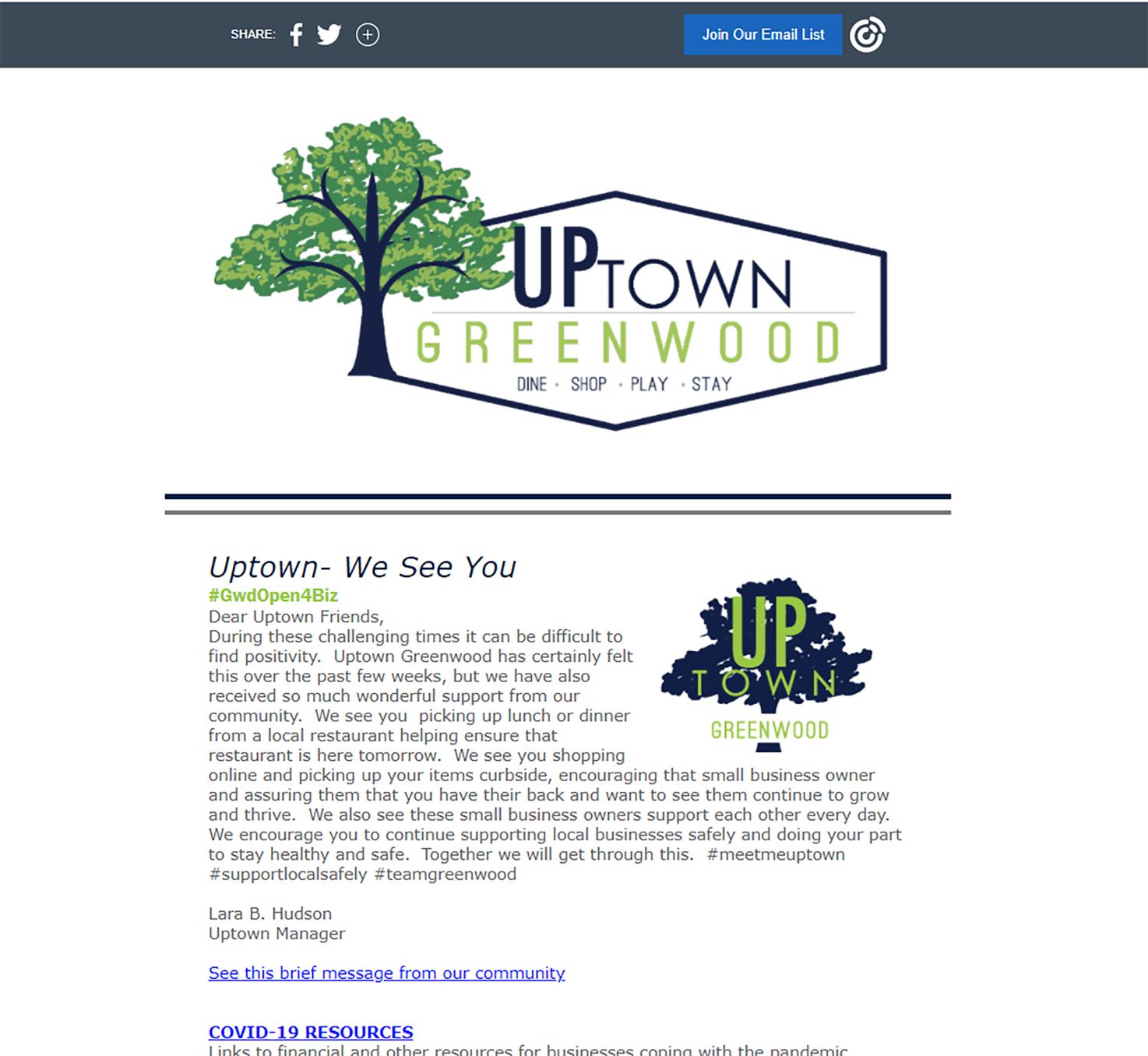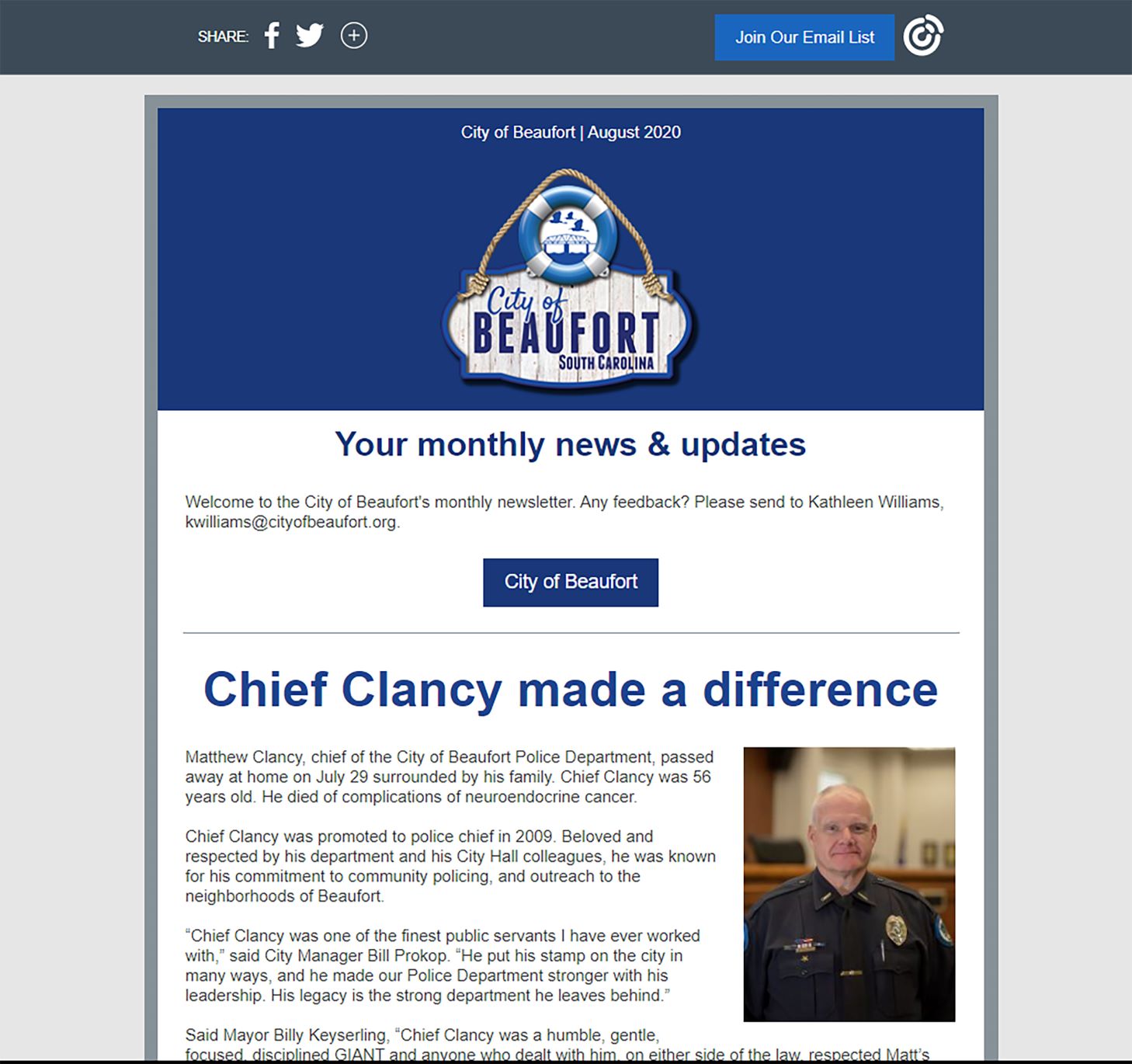Cities and towns have many ways to communicate with residents: direct mail, websites and social media. E-newsletters also provide a low-cost way for cities to reach out and help residents know what's going on.
Often powered by email marketing platforms like Constant Contact or Mailchimp, e-newsletters give subscribers the big municipal headlines before sending them to a city website or other digital locations for more information. In many cases, newsletters started small, but some cities are now using them as robust ways to engage residents and help foster a more vibrant community.

Uptown Greenwood
Uptown Greenwood, the city's central business district organization, provides a digital newsletter called Uptown Lowdown. Uptown Greenwood works with the city on the product, which includes information on the Uptown farmers market and splash pad. The monthly newsletter, which has been produced for about four years and has 8,000 subscribers, focuses on upcoming events, especially Greenwood's two major celebrations each year, the Festival of Flowers and the Festival of Discovery. It also contains brief write-ups on news and events and encourages readers to learn more from the Uptown Greenwood website or a social media channel.
"There's always things going on here," said Uptown Greenwood Manager Lara Hudson. "Whether it's maintenance or if there's a private event, just information that the community would need to know about accessing the farmers market and when they can come to the splash pad."
Sometimes Hudson will send out information between editions of Uptown Lowdown if something important comes up or the details of an event change.
"We spend most of our time on our website. That's where we're putting all of our information and that makes putting the newsletter together easier," Hudson said. "Our Facebook page definitely gets more engagement if we link to it from our newsletter."
Hudson said that information has become even more critical during the COVID-19 pandemic.
"The splash pad is a very popular activity in Uptown for families, especially now with everything going on," Hudson said. "I think residents are appreciative of the communication we give them because they're hungry for something to do right now."
Subscribers to the newsletter have to opt in, meaning they must request specifically to receive the emails. Finding new subscribers has not been easy this year, with many of the events that ordinarily make people want to sign up for the newsletter not happening. The city, with the help of its technology team, is trying something a little different.
"You used to just click on the [free Uptown] WiFi and were automatically connected. Now you have to put in an email address, accept terms and then you have the option to receive our newsletter," Hudson said.

Mauldin
The City of Mauldin's community development department handles everything from business recruitment and long-term infrastructure planning to the Mauldin Cultural Center. When Van Broad, director of community development, started, the city didn't have direct marketing communication with its residents and relied on an outside firm to provide the occasional news release.
"If you think about it, somebody is going to tell your story," Broad said. "Either you can tell it or let someone else tell it."
Part of the funding for the community development office's marketing efforts comes from accommodations taxes, and helps cover the cost of material Broad's team mails, and for the staff that produces and promotes the information digitally.
Broad described the earliest newsletters from 2016 as "very generic."
"Then [Cultural Affairs Manager] Keira [Heider] came on board, and she created an incredible template and really made an honest newsletter. It had information, it had factual reports, it had demographics information, it had stories about the community. She just took it to another level. It could be its own newspaper for the city."
The Mauldin Report, covering everything from public works to cultural affairs, is mailed, distributed in city offices and posted on the city's website. It is also promoted in a monthly e-blast and on social media.
"Every department has something going on," said Heider. "It's basically how do residents engage with their city and know what's happening in their city from council meetings to when you just want something to do."
For the Cultural Center, the team prints out an annual season preview, including shows, festival and educational opportunities, that is mailed to 25,000 homes in Mauldin. Individual events are promoted in weekly emails to subscribers.
The city's eblast goes to more than 2,600 subscribers while the Cultural Center has more than 4,200 subscribers. Heider said there is also a mailing list of folks who want to know about volunteer opportunities, and the city's recreation department plans to start an e-blast very soon.
"Residents can easily access information they do want but are not bombarded with information they don't want," Heider said.
As the effort has grown, so has the team's staffing, which includes marketing and design coordinator Jeannie Harmon.

Beaufort
The City of Beaufort's e-newsletter is the responsibility of Kathleen Williams, who became the city's first dedicated communications person in December 2019.
Williams said the biggest asset of the newsletter is to consolidate city information in one place that people may have missed on social media posts or as news releases on the website.
"I do think newsletters can be effective in terms of putting it all in one place in a way that social media, which tends to be a little more scattered, can't really offer," Williams says. "It reinforces news that's come out in the past month that is still timely and alerts people to anything upcoming.
"For the pandemic, it's been an incredibly important tool for sharing information."
Williams has included information on city office closings, how the public can do business with the city when offices are closed and information on the pandemic from the Centers for Disease Control and the South Carolina Department of Health and Environmental Control. She even included a feature on how to make a mask as she was letting residents know about the city ordinance requiring them to wear one.
The city's mask ordinance provided a great example, she said, of how information flows from the city. First, Williams posted a news release to the city's website with information about the ordinance. She produced several social media posts announcing the ordinance and linking to the website. In the next monthly newsletter, she reminded residents of the ordinance and thanked them for following it. The newsletter was sent to her 3,500 subscribers and it was posted on both the website and social media.
Williams recommends that any town looking to start or improve an existing newsletter should look for a staffer who can be dedicated to creating the newsletter, even if that's not their whole job. She also suggests hiring someone with a news or marketing background.
